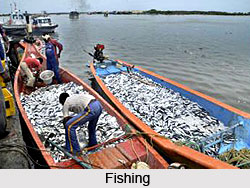 In Poducherry about 45% of the people depend on agriculture for their livelihood. 90% of the total area is irrigated. The predominant crop here is paddy. Pulses are also grown in large areas here. Crops like rice, coconuts, arcanuts, condiments, ragi, bajra, pulses, sugarcane, cotton, spices, groundnut and chilies are grown here. There is a well-established modern diary at Pondicherry. Fishing is an important occupation of the people here. There are about 28 sea fishing villages in the Union Territory. The main products exported in Puducherry are rice, fish, hides, skin etc. There are 23 large-scale industries and 79 medium scale industries here. There are about 5,400 small-scale industries here, which give employment opportunities to nearly 50,000 people.
In Poducherry about 45% of the people depend on agriculture for their livelihood. 90% of the total area is irrigated. The predominant crop here is paddy. Pulses are also grown in large areas here. Crops like rice, coconuts, arcanuts, condiments, ragi, bajra, pulses, sugarcane, cotton, spices, groundnut and chilies are grown here. There is a well-established modern diary at Pondicherry. Fishing is an important occupation of the people here. There are about 28 sea fishing villages in the Union Territory. The main products exported in Puducherry are rice, fish, hides, skin etc. There are 23 large-scale industries and 79 medium scale industries here. There are about 5,400 small-scale industries here, which give employment opportunities to nearly 50,000 people.
Industry: There are about 6,607 industries in Puducherry. The number of industrial units registered here are 6,634 units. The total profit from these industries works out to be Rs. 9,141.34 core. These industries manufactures products as textiles, computers and peripherals, UPS and other electronic products, consumer durables, fast moving consumer goods, pharmaceuticals, leather goods, earth moving equipments, sugar, yarn, spirit, beer, potassium chlorate, rice-bran oil, auto parts, disposable syringes, roofing sheets, washing machines, bio-polymers, steel tubes, LPG cylinders, etc.
Irrigation: 90% of the net cropped area is under irrigation. Irrigation in Puducherry is mainly through tube wells and tanks. There are 140 small tanks for harvesting surface water.
Power: In Puducherry the power requirements are met by availing share from the Central generating stations and by purchasing power from neighbouring State Electricity Boards. A combined Cycle Gas Power Plant of 32.5 MW is under operation. The T. R.Pattinam 110/11KV Substation associated with Gas Power Plant was commissioned in July 1997. One 110/22 KV sub-station at Thethampakkam was commissioned on 24 January 2001. A 230 KV line from Neyveli to Bahour was commissioned in June 2001, which is a second source of supply to the 230/110 KV Bahour Auto Sub Station.




















